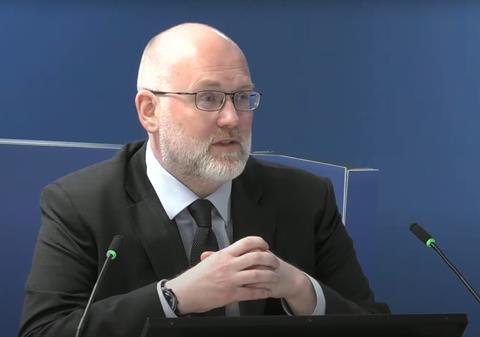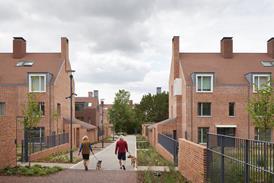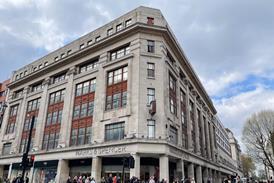Remark came in an email sent by DCLG’s Brian Martin 18 months before tower-block fire

The senior government official responsible for fire safety in buildings described combustible ACM panels as going “whoosh!” when ignited, the Grenfell Inquiry has heard.
Brian Martin used the phrase 18 months before the fire at Grenfell Tower in one of a series of bombshell emails shown to the inquiry yesterday.
He had been responding to a string of major fires in the Middle East caused by aluminium faced and plastic-cored ACM panels, the type which were used on the flawed refurbishment of Grenfell Tower.
Replying to an email from his colleague Bob Ledsome, who had asked if there was anything officials need to “worry” about in UK building regulations in terms of ACM, Martin said: “Nothing new here. The fire is most likely to be similar to several others that have hit Dubai over the last couple of years.
“It relates to a cladding product which is a laminate of aluminium and polyethylene (Or similar) this stuff [is] very rigid and makes nice shiny buildings.
“Sadly when it gets exposed to a fire the aluminium melts away and exposes the polyethylene core. Whoosh!”

He added that UK building regulations were “designed to prevent this kind of thing” because they stated that “filler” materials were required to meet the tough fire rating of “limited combustibility”.
He said the plastic core of ACM panels “would be considered as a filler material so should not be used over 18m”.
But Martin did not mention that he had been warned by a group of industry experts that ACM was being used on high-rise buildings across the UK because the term “filler” was being widely misunderstood by construction professionals.
The inquiry has already heard that Martin attended a meeting of the Centre for Windows and Cladding Technology in August 2014, where he and Sarah Colwell, a scientist at the Building Research Establishment, had agreed to publish a ”frequently asked questions” explainer on the government’s website clarifying the meaning of the word “filler”. The explainer was never published.
Yesterday, Richard Harral, former head of technical policy for building regulations at the Department for Communities and Local Government, was questioned by the inquiry on Martin’s email, which he had been copied into. He said he had not been aware of the debate over the term “filler”.
Counsel to the inquiry Kate Grange QC asked: “Can you think of any possible reason why Mr Martin isn’t telling you and Mr Ledsome about the fact that he knew full well there was a debate about this within the industry?”
Harral said “no”.
“He should have done, shouldn’t he?” Grange replied. “He should have had a much longer email which explained that this was an issue that had been rumbling for some time and on which pretty authoritative bodies had raised concerns; yes?”
Harral said that he “would have wanted him to”, adding that he was not aware that any steps were being taken at the time to ascertain whether ACM panels were being used on tall buildings in the UK.
Grange asked: “Wasn’t it just common sense to anybody looking at this information that it was screaming out for somebody to check whether we had this problem in the UK?”
Harral replied: “In retrospect, you know, of course I wish that that’s where we’d got to.” But he added that his team was “hidebound” and “beaten up” by the structures of the department.
Technical policy at DCLG was ‘suffocating’
Earlier, he admitted that adding an explainer to the building regulations clarifying that “filler” applied to combustible cores of cladding panels would have been a “very simple thing to do”.
But he said that technical policy at the department had been “suffocating” and officials were not able to feel “confident or adventurous or forward-looking”.
The inquiry has already heard that ministers had set officials a “red tape challenge” where new regulations could only be added if existing ones were removed.
By 2016, the policy had been strengthened to mean that three regulations needed to be removed for every new one added.
Yesterday’s hearing was also shown minutes from another CWCT meeting attended by Martin where he accepted that the section on fire safety guidance on “filler” materials was “poorly written and open to interpretation”.
Martin had also agreed that the heading of the passage, which was titled “insulation materials/products”, was “misleading” and would be changed in an upcoming revision of the regulations.
Harral said he had never seen these minutes, and had never been informed that Martin and industry professionals considered the section on “filler” materials to be misleading.
Asked why Martin had said in his January 2016 email that ACM presented no problems in the UK because it fell into the category of “filler” so was banned, Harral said: “I can’t offer you an explanation for that”.
Asked if Martin had informed him about the “historic and ongoing” use of ACM at any time before the Grenfell Tower fire, Harral said he did not recollect being informed.
In his closing statement of the hearing, Harral said: “I find it very difficult to take in what I’ve learnt over the past two days.”
He added: “I find it very difficult to understand how we’ve actually come to where we are, in many ways.
“I deeply regret the failings, my failings, that have been exposed by the evidence that we’ve heard, and I can only apologise to the victims and their families of Grenfell Tower and all who have been affected.
“I am deeply ashamed of the part that I’ve played in this absolute tragedy, and I hope that we can learn key lessons about the regulatory culture we have in this country, I hope that we can learn about the need to temper our obsession with innovation and the predominance of economic theory over more pragmatic human concerns, and I hope that we end up with an industry that actually is serving the people it aims to deliver for in a way that keeps them safe.”
The inquiry continues.















